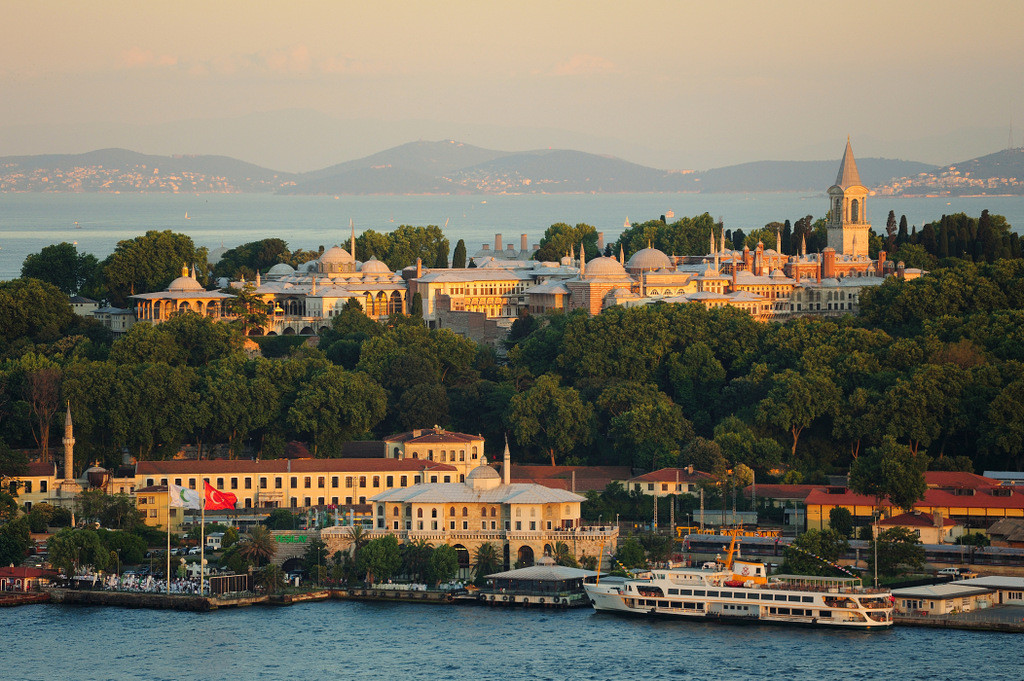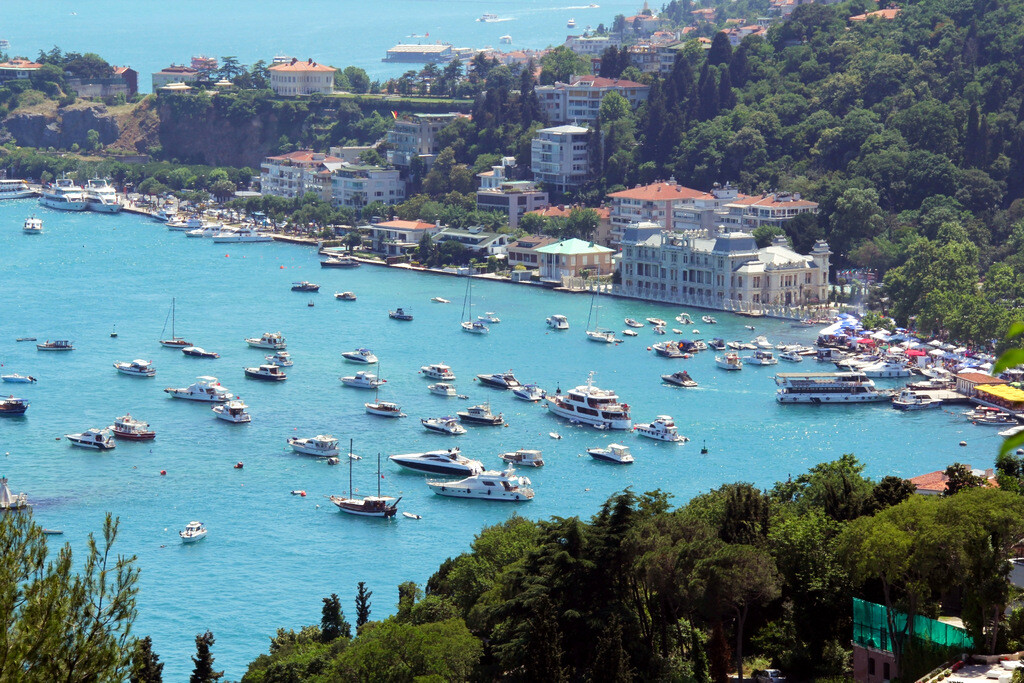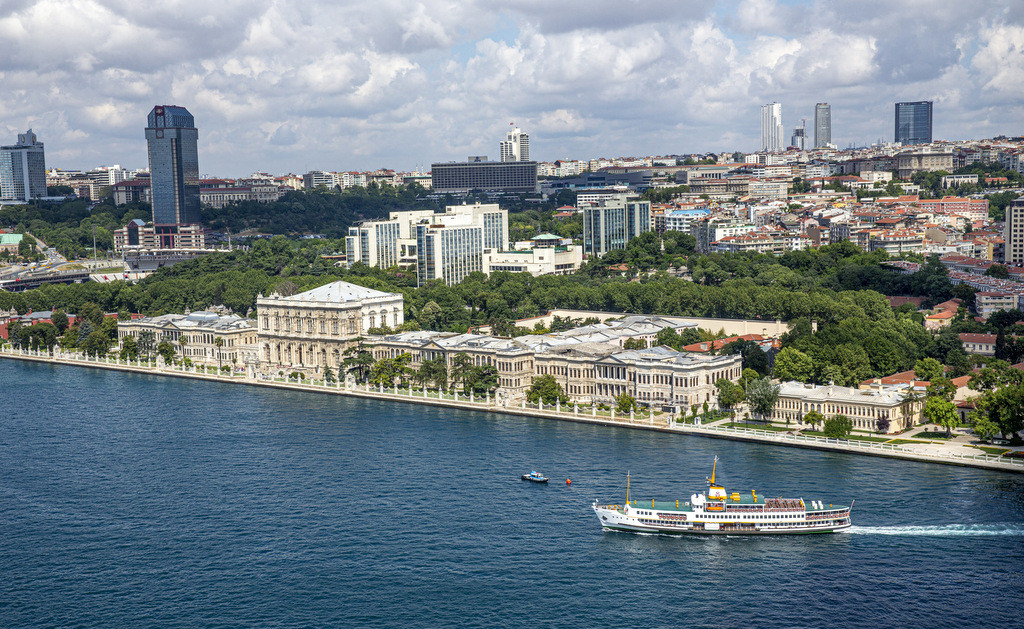Where the Bosphorus meets the sky in a shimmer of silver and blue, Dolmabahce Palace rises like a final verse in the poem of an empire. With crystal chandeliers grander than any ballroom waltz, and staircases that seem to float in air, this palace tells the story not of conquest — but of elegance, longing, and change.
Built in the twilight of the Ottoman era, Dolmabahce blends Ottoman grandeur with European charm, echoing both Versailles and Istanbul in every gilded detail. It’s where sultans walked in silk slippers… and where the founder of modern Turkey, Mustafa Kemal Ataturk, drew his final breath.
Dolmabahce Palace entrance fee in 2025 is 1800 Turkish Liras. Please note that the Istanbul Museum Pass is not valid here. Visiting hours are daily from 09:00 in the morning until 17:00 in the evening. (Information last reviewed on December 11, 2025 — see more details under the relevant sections below.)
If you’d like to secure a skip-the-line entry for Dolmabahce Palace, you can 👆
book your fast-track ticket here
. This official option helps you avoid waiting in long queues at the ticket counters, especially during the busy spring and summer season.
Throughout the rest of this guide, you’ll find clear and practical advice to help plan your visit. Having worked as a professional tour guide in Istanbul for more than two decades, I’ve gathered here the most frequent questions from my guests — along with straightforward answers that will make your experience at Dolmabahce Palace smoother and more rewarding.
📌 Dolmabahce Palace 2025 Visitor Summary
A practical guide to visiting Dolmabahce Palace in 2025 — ticket details, visiting hours, and essential tips!
🏷️ Ticket Price: 1800 TL (approx. €38) — includes Selamlik and Harem sections
⏰ Opening Hours: 09:00 – 17:00
🙏 Closed: Mondays
🎫 Museum Pass: Not valid at Dolmabahce Palace
🚀 Skip-the-line: Online ticket recommended. (you can book from the blue link below)
📍 Location: Besiktas, Istanbul
📅 Last Updated: December 2025
Insider’s Note: From my 20+ years as a licensed tour guide in Istanbul, I can confidently say that the best time to visit Dolmabahce Palace is early in the morning, right when it opens at 9:00 AM. This allows you to collect your audio guide (included in the standard palace ticket) without waiting and enjoy the magnificent furnishings and paintings at your own pace before the crowds arrive. If mornings don’t work for you, consider one of the skip-the-line ticket options mentioned above.
History of the Dolmabahce Palace
The history of Dolmabahce Palace goes back 150 years. However, to properly tell the history of the palace, we need to rewind a little and go to the 15th century. The first palaces built after 1453, the year the Ottomans conquered Constantinople, were very different from Dolmabahce.
1. First Ottoman Palaces in Istanbul

The first Ottoman palaces in Istanbul were built in the 15th century. Sultan Mehmed II, the first Ottoman sultan who set foot in Istanbul, first built a palace in Beyazit (near the Grand Bazaar). He lived in this palace during the construction of Topkapi Palace in Sultanahmet.
The Topkapi Palace was designed by the Sultan as a meeting center where governmental affairs could be discussed and a school for future bureaucrats. Topkapi Palace, which consists of four large courtyards, reflected the traces of the Central Asian tradition of the Turks.
During the period when the Ottoman Empire was at its peak, the Ottoman sultans, who were mentioned most in history, lived in this palace. At the request of Hurrem Sultan, the wife of Suleiman the Magnificent, the Harem in the Old Palace in Beyazit was moved to the Topkapi Palace.
When the sultan’s mother, sisters and wives moved to the Topkapi Palace, the classical palace expanded to the shores of the Marmara Sea with new buildings. During this period, life was limited to Historic Peninsula of Istanbul.
Insider’s Note: If you’re curious about how Ottoman architecture evolved over time, compare the elegant simplicity of Topkapi Palace in the Old City with the European-style opulence of Dolmabahce Palace by the Bosphorus. These two palaces perfectly reflect the shift from classical Islamic design to 19th-century Western aesthetics—offering a fascinating glimpse into the Empire’s rapid modernization.
2. Bosphorus Coast Becomes Popular

By the 18th century, the Ottoman sultans began to stay in the coastal district of Besiktas, so the Bosphorus shores became more popular. Life, which was limited to the Historic Peninsula in the early period, began to spread towards the Bosphorus during this period. Especially districts like Beyoglu and Besiktas were developing rapidly.
The first Ottoman ruler, who never lived in Topkapi Palace after he became Sultan, was Mahmud II. The janissary rebellion, which resulted in the death of his predecessor Selim III, left unpleasant memories in the mind of the young sultan.
Mahmud II paved the way for reform and westernization in the Ottoman Empire. The Janissary army (Ottoman elite troops), which had lost its function, was removed and replaced by an army in the western order. Clothes and lifestyle were adapted to the modern world.
Insider’s Note: One of the most striking visual clues to the Ottoman Empire’s cultural transformation can be found in the portrait gallery of Topkapi Palace. Compare the traditional depiction of Sultan Selim III, seated on a divan in classical Ottoman style, with the portrait of Sultan Mahmud II in a Western-style military uniform reminiscent of Napoleon. This sharp contrast reveals how rapidly the royal court embraced European aesthetics during the 19th century.
3. Who Built the Dolmabahce Palace?

The son of Sultan Mahmud II, Sultan Abdulmecid, received a modern education. Abdulmecid, who ascended the throne at a time when the Ottoman Empire was in a great change, was closely following the developments in the world.
Financial developments in the world have found their response in Istanbul and banks and insurance companies were opened one after the other. Investments made by Western businessmen in Istanbul were supported by Ottoman citizens, especially non-Muslims.
In the last century of the Ottoman Empire, the prominent figures of the capital sent their children to Paris for education. During this period of rapid westernization of the lifestyle, French became the second language.
Ottoman citizens studying in Paris carried the western architectural style to Istanbul. The Balyan family, who had been a palace architect for a period in the 19th century, was brought up in the same way.
In the 1850s, Sultan Abdulmecid decided to build Dolmabahce Palace. Nikogos Balyan and Garabet Balyan built a structure using Neo-Classical and Baroque architectural styles. They also crowned the architecture of the building with Ottoman decoration elements.
Insider’s Note: While Dolmabahce Palace often steals the spotlight, it represents just the tip of the iceberg when it comes to the legacy of the Balyan family. These visionary Armenian architects reshaped the Bosphorus shoreline with elegant palaces and waterfront mosques, crafting much of what we now recognize as the modern visual identity of Istanbul. Their transformative impact is often compared to that of Mimar Sinan in the 16th century.
4. Interior Decoration of the Palace

The most popular objects of the period were used for the interior decoration of the palace. In order to crown these mostly imported objects with Ottoman style, workshops producing royal Turkish carpets were established in Hereke.
The furniture used inside the Dolmabahce Palace was imported from France. The magnificent crystal chandeliers were brought from England. Talented masters and painters from Italy also decorated the walls of the palace. The infrastructure of the palace was equipped with the latest techniques of the 19th century.
Insider’s Note: The Ottoman sultans established exclusive carpet workshops in Hereke to create masterpieces solely for palace use. This royal initiative gave rise to the Imperial Court Carpet tradition — a refined, luxurious branch of Turkish weaving that reached its peak after the 16th century. Earlier than that, the dominant style was the simpler and deeply symbolic Nomadic Rugs, handwoven by Anatolian villagers. Together, these two traditions reflect the journey of Turkish carpet-making from humble roots to imperial elegance.
Dolmabahce Palace Entry Fee 2025
Dolmabahce Palace entrance fee is 1800 Turkish Liras in 2025. This ticket includes access to the main palace (Selamlık), the Harem section, and the Painting Museum. Please note that Museum Pass Istanbul is not valid at Dolmabahce Palace. This information was last updated on December 11, 2025.
🎟️ Skip the Line at Dolmabahce Palace
Want to avoid long ticket lines and enjoy the palace at your own pace? Below are two excellent ways to explore Dolmabahce Palace or admire it from the water. Both options include smooth entry and great reviews.
Highly rated experiences • Mobile tickets • Instant confirmation
Dolmabahce Palace Opening Hours 2025
In 2025, Dolmabahce Palace is open to visitors daily from 09:00 AM to 5:00 PM, except on Mondays, when it is closed. This information was last updated on December 11, 2025.
There may be changes in the entrance hours of the museums in Istanbul. Before going to the museum, I recommend you to visit the official website of the palace and review the latest situation.
How to Get to Dolmabahce Palace?

Dolmabahce Palace is located along the shores of the Bosphorus, between the neighborhoods of Kabatas and Besiktas. Unlike many of Istanbul’s other historical landmarks that cluster around Sultanahmet, Dolmabahce stands apart — both geographically and stylistically — with its elegant façade facing the sea. It’s just north of Tophane and Karakoy, and a pleasant coastal walk south of Besiktas district.
If you’re coming from Taksim Square, the easiest route is to take the F1 Funicular down to Kabatas Station, which is just a 5-minute ride. From Kabatas, Dolmabahce Palace is less than a 10-minute walk. Simply exit the funicular station, cross the tram tracks, and walk northeast along Meclis-i Mebusan Avenue, keeping the Bosphorus on your right. You’ll soon see the grand palace walls and the clock tower rising just beyond the trees — a clear sign you’ve arrived.
If you’re staying in Sultanahmet, take Tram T1 from Sultanahmet Station toward Kabatas. The ride takes about 20–25 minutes. Once you reach the final stop (Kabatas), follow the same short walk along the water to reach the palace gates.
Visitors arriving by ferry can also disembark at Kabatas Pier, which is served by boats from Kadikoy and Uskudar. From the pier, it’s a quick walk — follow the signs toward Dolmabahce Sarayi, or simply let the ornate gate and elegant architecture guide your steps.
Whether you’re approaching by tram, ferry, or on foot, the journey to Dolmabahce Palace offers one of the most scenic approaches in the city — with sweeping views of the Bosphorus, the occasional passing ferry horn, and the promise of imperial grandeur just ahead.
Then make sure to visit these other historical treasures nearby — each one offering a unique glimpse into Istanbul’s layered past:
- Hagia Sophia – A timeless marvel that bridges empires and faiths
- Topkapi Palace – The imperial residence of Ottoman sultans for 400 years
- Blue Mosque – An iconic masterpiece of Ottoman architecture and faith
- Galata Tower – Enjoy breathtaking views of Istanbul from above
- Basilica Cistern – Discover the mysterious underground world of ancient Constantinople
Conclusion
Dolmabahce Palace isn’t just a royal residence — it’s where the Ottoman Empire embraced the beauty of Europe while holding on to its imperial soul. With its crystal chandeliers, sweeping staircases, and views over the Bosphorus, it tells a story of power, elegance, and transition.
After your visit, take a few steps toward Besiktas Pier, where ferries glide between continents. Or walk along the vibrant coastal promenade toward Ortakoy, a charming neighborhood filled with cafés, street art, and a waterfront mosque that sparkles at sunset.
If you’re looking to explore more palatial beauty, head inland to Yildiz Park, once part of the palace’s extended grounds — perfect for a quiet stroll under ancient trees.
And as the day winds down, don’t miss grabbing a cup of Turkish tea at a seaside café, watching the ferries cross the strait. Because in Istanbul, history doesn’t just live in museums — it sails, whispers, and lingers in the sea breeze.
Written by Serhat Engul
Hi,
Do you know if ICOM card is valid to visit Dolmabahce Palace and Beylerbeyi Palace?
I wrote about this to the info service of the official website but I had no answer. Thank you for your very updated website.
Dear David Hibernie, Unfortunately, I have no information about this. Dolmabahce Palace and Beylerbeyi Palace are operated by the National Palaces Administration and you can access their official website at this address.
Is there a special rate or discount for museum pass holders?
Or do we have to pay full price?
Thank you for your return.
Hello Satki, unfortunately there is no discount for museum pass holders at Dolmabahce Palace.